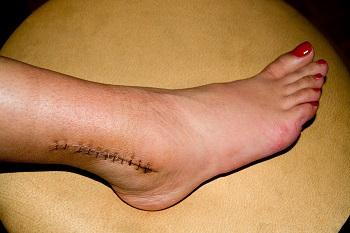 Bunions, hammertoes, arthritis -- foot surgery is the final remedy many different kinds of pain in the foot and ankle. These problems of the foot can cause severe pain in some patients, and relief can often be found through alternative treatments. In extreme cases though, these alternative treatments won’t be effective, resulting in the need for foot surgery. Your podiatrist will work with you to determine the best treatment option for your ailments.
Bunions, hammertoes, arthritis -- foot surgery is the final remedy many different kinds of pain in the foot and ankle. These problems of the foot can cause severe pain in some patients, and relief can often be found through alternative treatments. In extreme cases though, these alternative treatments won’t be effective, resulting in the need for foot surgery. Your podiatrist will work with you to determine the best treatment option for your ailments.
Bunion Surgery
Bunion surgeries fall into two major categories:
- Head procedures that treat the big toe joint
- Base procedures concentrate on the bone near or behind the big toe joint.
Most bunion surgeries are performed on an outpatient basis at a surgical center or hospital. It is important to set aside an entire day for your surgery, even though you may be in the facility for only half a day. Bunion surgery is usually performed with a local anesthetic and it can be combined with a sedation medication to put you into a “twilight” sleep so that you are fully relaxed for the procedure.
After surgery, patients are often given a long-acting anesthetic and pain medication, which is why someone else must drive you home. The type of procedure you have will determine the degree to which you can put weight on the foot immediately after the surgery. Some patients may have to use crutches, while others may be sent home wearing a surgical shoe.
During the first week after surgery, you will need to keep your foot elevated as much as possible. Ice packs should also be applied for the first three to four days to reduce swelling. Limited walking is often required over the first two weeks to promote healing. Your podiatrist may also instruct you on some basic exercises that need to be performed daily.
Ankle Surgery
Ankle surgery may be required to correct a serious deformity of the ankle and its bone structure. Injury, birth defects or changes throughout the course of life are the usual culprits. Disease, such as diabetes, rheumatoid arthritis and neuromuscular conditions, may cause severe foot and ankle deformities that, over time, cause pain and difficulty walking. Surgeries of the ankle emphasize the realignment of the structure either around or after removal of the deformity.
Various kinds of internal and external fixation devices are often required to maintain the appropriate alignment during, and beyond the healing process. Varying in complexity and severity, many ankle surgeries are conducted on a same-day, outpatient basis. Patients need to arrange for another person to take them home after surgery and to stay with them for the first 24 hours following the surgery. Post-operative instructions provided by your podiatrist will give you the information needed to care for your recovering ankle following surgery.
When foot problems occur, your feet deserve your full attention and the care of your podiatrist. Foot surgery can often be avoided with conservative treatments, but if your foot pain is excessive foot surgery may be the best solution. Contact your podiatrist in today for further consultation and treatment of your foot ailments.

